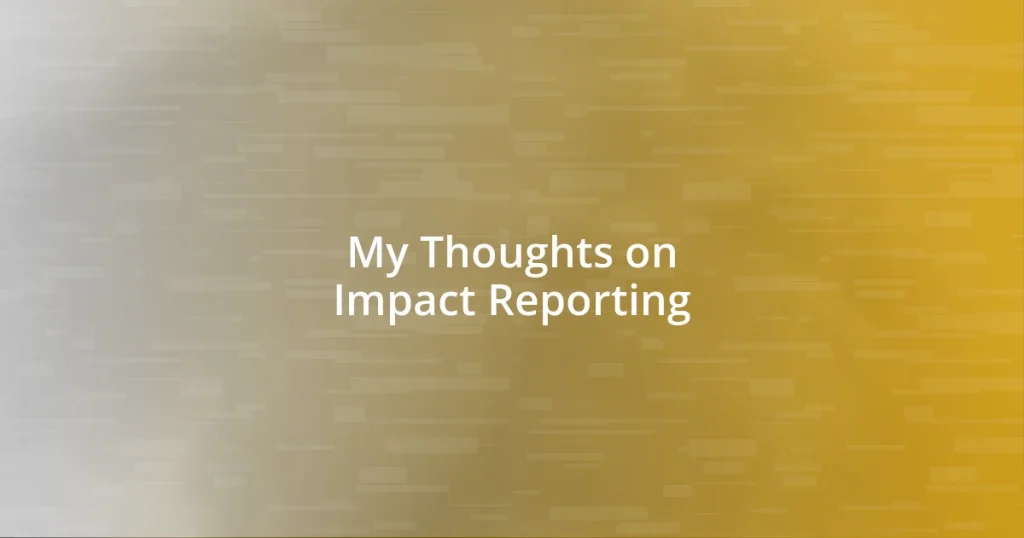Key takeaways:
- Impact reporting combines quantitative data and qualitative narratives to showcase an organization’s tangible effects and build emotional connections with stakeholders.
- Key components of effective impact reporting include setting clear objectives, incorporating stakeholder perspectives, and presenting data in an engaging format.
- Future trends in impact reporting involve integrating technology for real-time insights, adopting artificial intelligence for data analysis, and fostering greater transparency and community involvement in the reporting process.

Understanding impact reporting
Impact reporting serves as a fundamental tool for organizations to communicate the tangible effects of their initiatives. I remember the first time I delved into an impact report from a nonprofit I deeply respected. It was eye-opening to see not just the numbers, but the heartfelt stories behind them. Isn’t it astonishing how a few well-documented anecdotes can encapsulate the true essence of change?
Understanding impact reporting goes beyond just figures and metrics; it’s about interpreting the narrative woven through those numbers. I often find myself asking, how does this data resonate with the lives of those affected? Each statistic tells a story, and each story reveals the organization’s mission in action, which makes it all the more relatable.
As I navigated various impact reports over the years, I noticed that the most effective ones struck a balance between quantitative data and qualitative insights. They don’t just inform; they inspire. It’s like taking a peek behind the curtain to see the real-world implications of work that might seem abstract at first glance. These reports can cultivate a deeper connection between stakeholders and the mission at hand, reflecting the profound ripple effects that thoughtful actions create.

Importance of impact reporting
Impact reporting holds significant importance as it empowers organizations to showcase their achievements and the influence they wield on communities. I recall a time when I reviewed an organization’s impact report and was genuinely moved by how clearly they demonstrated their contributions. The thoughtful integration of data and personal narratives made their accomplishments feel real and relatable. It wasn’t just about numbers; it was about the lives impacted, and that emotional connection resonated with me deeply.
Here are a few key reasons why impact reporting matters:
- Transparency: It builds trust between the organization and its stakeholders by openly sharing successes and challenges.
- Informed decision-making: Effective reporting helps stakeholders understand how resources are used, guiding them in future investment choices.
- Engagement: Impact reports can spark passion and involvement from the community, motivating them to support the organization’s mission actively.
- Continuous improvement: By reflecting on past efforts, organizations can adapt and innovate, ensuring that they maximize their positive impact.
When I see organizations embracing impact reporting with sincerity, I feel inspired and motivated to contribute to that cause. It’s reassuring to know that my support aligns with tangible outcomes, creating a cycle of positivity and change.

Key components of impact reporting
When I reflect on the key components of impact reporting, several elements shine brightly in guiding how organizations communicate their influence. At the core, setting clear objectives is crucial. Without well-defined goals, it becomes hard to measure progress or communicate results effectively. I remember working with a group that struggled to articulate their mission until they established specific targets. Suddenly, everything clicked, and their reports became powerful narratives of achievement.
Another crucial aspect is the inclusion of stakeholder perspectives. Listening to the voices of those affected by the organization’s work can provide invaluable context. I once attended a presentation where beneficiaries shared their experiences, and it was breathtaking to see how it humanized the data. Hearing their stories transformed raw figures into something palpable and real.
Lastly, the presentation of data itself plays a significant role in impact reporting. A well-organized format that employs visuals can make complex information digestible. I’ve seen reports with infographics that not only captured attention but also clearly conveyed important findings. It’s like telling a captivating story that flows naturally, inviting the reader in rather than overwhelming them.
| Key Component | Description |
|---|---|
| Clear Objectives | Setting specific and measurable goals to guide reporting and highlight achievements. |
| Stakeholder Perspectives | Involving beneficiaries’ voices to add depth and relatability to data interpretation. |
| Data Presentation | Using visuals and organized formats to make information engaging and easy to understand. |

Best practices for effective reporting
When it comes to impact reporting, I’ve found that being concise yet thorough is key. In my experience, organizations that prioritize clarity in their messaging tend to resonate more with their audience. Remember the last time you sifted through a report that seemed endless? It’s exhausting! Striking a balance between brevity and detail ensures stakeholders grasp the essence without feeling lost in jargon.
Another best practice is to incorporate compelling stories alongside data. I recall a particular nonprofit that shared a short video snippet of a beneficiary’s journey. It wasn’t just statistics; it was about a real person transforming their life with the organization’s help. This emotional storytelling, paired with the right data, brings the report to life. It compels readers to connect and, perhaps, even reflect on their involvement.
Lastly, I believe regular updates are crucial. When organizations keep their stakeholders in the loop, it fosters a sense of community. I often think about how gratifying it feels when I see the evolving impact of a cause I support. It makes me more likely to engage further. So, how often should organizations communicate? I’d say at least annually—but quarterly could really deepen that connection. Frequent touchpoints transform isolated reports into an ongoing dialogue, encouraging lasting relationships and commitment.

Tools for impact measurement
When it comes to tools for impact measurement, I’m drawn to a few standout platforms that can truly elevate the reporting process. For instance, I once worked with a nonprofit that utilized a software called Logic Model Builder. This tool allowed us to visually map out our goals and specify the measurable outcomes we wanted to achieve. It was incredibly eye-opening to see how a clear structure could transform abstract ideas into actionable plans, and it made discussing progress so much easier with our team.
Data collection tools are also essential, and I’m a huge fan of surveys and feedback forms. After implementing a simple online survey, the insights we gained were beyond what I had anticipated. The responses not only highlighted areas of success but also shed light on unexpected challenges. This real-time feedback was invaluable, making me realize how important it is to listen actively to those directly impacted. Don’t you think that engaging with stakeholders in this way adds layers of understanding that mere numbers could never convey?
Finally, I believe that visualization tools are game-changers for impact reporting. During one project, we created a series of infographics that distilled complex data into engaging visuals, and the response was overwhelmingly positive. It struck me how much more people engaged with our findings when they could see the information presented creatively. Why does data have to be boring, right? When you highlight key achievements through visuals, it invites everyone into the story and encourages them to be part of the journey.

Common challenges in impact reporting
Impact reporting is certainly not without its challenges. One significant hurdle I’ve encountered is the difficulty of aligning diverse stakeholder expectations. In one project I managed, stakeholders had varying definitions of success. This disconnect not only led to confusion but also intensified pressure on our team. Isn’t it frustrating when everyone’s on a different page? Establishing a common understanding from the outset could have streamlined our efforts significantly.
Another challenge I frequently face is data inconsistency. In a recent initiative, I saw firsthand how different data sources led to conflicting results. We had to invest extra time just to reconcile these discrepancies, making me realize how essential it is to establish standard metrics early on. It’s disheartening when you think you’re making progress, only to find your reports are muddied by unreliable data. When clarity is paramount, inconsistency feels like an uphill battle.
Lastly, communicating impact effectively can be a real struggle. In my experience, jargon-heavy language often alienates the very audience we aim to engage. I once worked with a group that filled its reports with technical terms that were, quite frankly, impenetrable to the average reader. This experience taught me the importance of tailoring our message to our audience. How can we expect engagement if our language fails to connect? It’s crucial to be relatable and clear—after all, we’re not just sharing data; we’re sharing stories that matter.

Future trends in impact reporting
As I look ahead to the future of impact reporting, I can’t help but feel excited about the integration of technology. I remember attending a workshop where we discussed how artificial intelligence could analyze vast data sets to extract trends that humans might overlook. Imagine being able to predict the potential impact of a project before it’s even launched! It’s a game-changer that could empower organizations to make data-driven decisions with unprecedented accuracy.
Another trend I envision gaining momentum is the rise of real-time reporting. I recall a project where we had to wait for quarterly reports to assess our impact, which felt like trying to pilot a ship without a compass. What if we could have continuous, up-to-date insights instead? This shift would not only enhance our responsiveness but also create a culture of accountability that drives performance and engagement among stakeholders.
Finally, I believe there’s going to be a stronger push towards greater transparency and stakeholder involvement in impact reporting. During a recent engagement, I witnessed how involving community members in the narrative-building process brought deeper connections and authenticity to our report. Isn’t it fascinating how collaboration can transform perceptions? I truly think that inviting voices from those directly affected creates a shared narrative, fostering trust and a sense of ownership over collective outcomes.















